Visiting the Merlion: Complete guide to costs, transport, time
The Merlion is the mythical creature of a half-lion half-fish said to represent Singapore’s origins as a fishing village, and aspirations and progress as the lion city. Being surrounded by the scenic Marina Bay, the Merlion is one of Singapore’s top five free-access attractions and something that I recommend every visitor to Singapore check out (even if you’re only in the city for a day).
In this complete guide to visiting the Merlion I’ve gone into more detail on the following:
- Costs of visiting the Merlion (he’s free to visit, but you might want to do other activities in the vicinity)
- How much time to spend at the Merlion (he’s quick to visit, but linger to explore park and the bay)
- What to do when visiting the Merlion (selfies, food and more)
- How to get to the Merlion (MRT, bus, or even river cruise)
- Best time to visit the Merlion (does he ever close?)
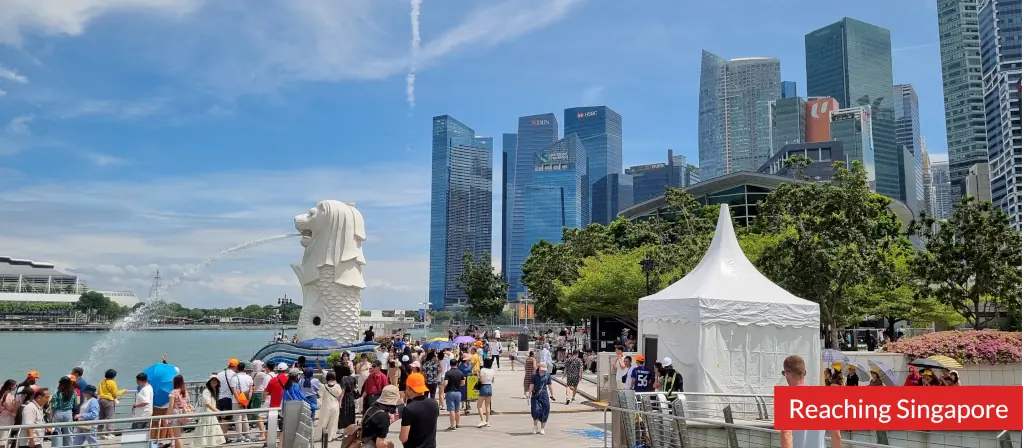
2. Cost of visiting the Merlion
The Merlion is free to visit. There is no ticket required to visit the Merlion and take a photo with him.
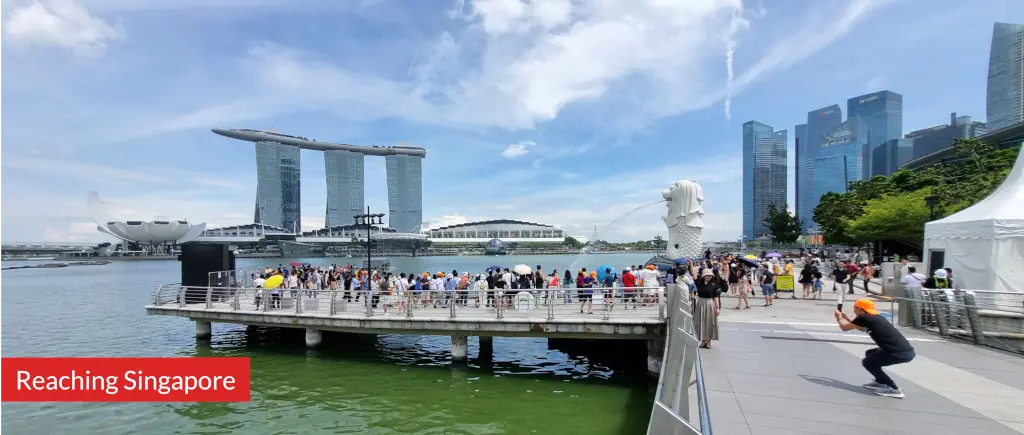
Transport to the Merlion typically costs S$1.20 to S$1.80 by public transport, or S$15 to S$30 by taxi, depending on where you are coming from. See my How to get to the Merlion section below for more details.
Eating at the Merlion park can cost between S$6 and S$50 per person depending on whether you’re eating snacks out in the open or sitting down at a restaurant. Some of the highlights include:
- Ice creams
- Fresh coconuts
- Burgers (Mos burger or OverEasy)
- Coffee (Starbucks)
If you can get a booking, Michelin starred Saint Pierre serves a 2-course lunch starting at S$158 (plus tax and service charge) per person. The restaurant is located behind the Merlion and has fantastic views over Marina Bay.
3. What to do when visiting the Merlion
Taking a selfie is the iconic thing to do when visiting the Merlion. Collecting the water spewing forth from the Merlion’s mouth is the popular selfie pose, and this can be taken from either side of the Merlion.
My favourite selfie spots are on the pier, or right up close on the steps at his feet. Be careful not to slip and fall in the water when using these steps (but this is the reason I like it, as many people do not dare to get so close so it’s less crowded).
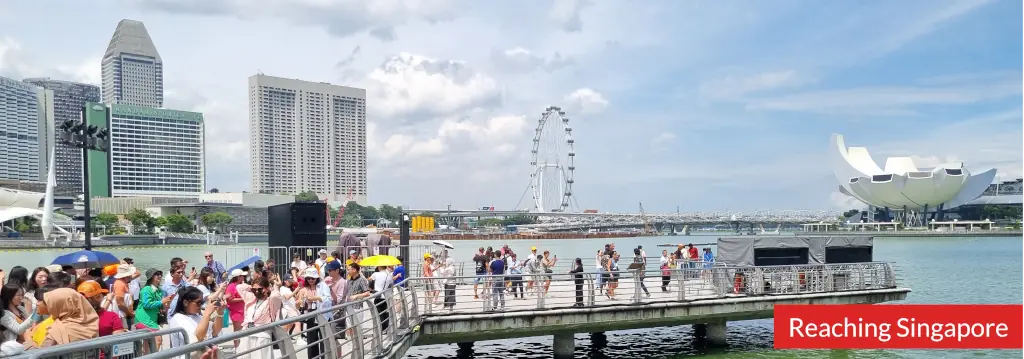
Exploring Marina Bay is the next most popular activity when visiting the Merlion. Marina Bay is home to fantastic views of the Merlion and its Fullerton Building backdrop, but also of the CBD and Marina Bay Sands.
Some of my favourite viewing points around Marina Bay from the Merlion side include:
- Jetty sticking out into the bay - fantastic view of the CBD backdrop behind the Merlion
- Steps under the Merlion - please don’t slip, but I’ve found this to be the best place to get a selfie with no one else in it
- From the Jubilee Bridge - sweeping views around the Bay with the Merlion dwarfed by the modern development of Singapore’s CBD
Cycling is a great way to enjoy the view, and I often recommend hiring a bicycle in the area and cycling from the Merlion, around the bay, past Marina Bay Sands and into Gardens by the Bay. Check out my How to get to the Merlion section below for more detail about cycling.
A Light and Water Show is put on by Marina Bay Sands every evening that can be viewed for free. While the Marina Bay Sands area is the best place to view it, I also like watching from the Merlion side. The 15 minute show starts at 8pm each evening.
River cruises can be made from Merlion Park. These are 40 minute jaunts along the Singapore River with a few stops along the way. The operating company from the Merlion is called WaterB, however another company called Singapore River Cruises also offers river journeys in the area (they operate from the Bayfront South Jetty at the other end of Marina Bay). See my How to get to the Merlion section below for more details.
If you’re visiting the Merlion in the evening, I often recommend to visitors to go to Lau Pa Sat next. Lau Pa Sat is the famous satay street where after 7pm each night the street is closed to traffic so that diners can enjoy fresh satay in the open air. It takes about 10 minutes to walk to Lau Pa Sat and I strongly recommend braving the queues to order your satay from Stall 7 and 8.
4. How much time to spend at the Merlion
While it usually only takes 15 minutes to have a selfie with the Merlion, I often recommend visitors spend a bit more time in the area to explore Marina Bay and its incredible views.
5. How to get to the Merlion
My preferred way of getting to the Merlion is by taking the MRT to Raffles Place station (on the green East-West Line and red North-South Line), and then walking over using the Fullerton Building underpass. This gives you the full experience of Singapore’s modernity with the MRT and a street of high-rise office towers, as well as a brief history of Singapore and the Fullerton building’s past as the general post office (including the tale of Singapore’s first gold purchase using a torn USD 1 note).
A quick summary of the ways of getting to the Merlion is in the table below:
| Transport | Approach |
|---|---|
| MRT | Use Exit H from Raffles Place station |
| Bus | From Little India use route 131; from Kampong Glam use routes 100 or 107 |
| Taxi | Set the destination to Merlion Park, then walk through the building after the taxi drops you |
| Big Bus Tour | Use the Fullerton Square stop |
| Cycle | Bicycles can be rented from City Scoot @ Esplanade, cycle over the Jubilee Bridge to get to the Merlion |
| Boat | Singapore river boat rides that stop at the Merlion are operated by WaterB |
I’ve gone into detail on each of these below:
Merlion transport: Train (MRT)
Taking the MRT is usually the way I recommend to visitors to get to the Merlion. To arrive at the Merlion by MRT:
- Take the MRT to Raffles Place station (located on the green East-West Line and red North-South Line)
- Head to Exit H and proceed up to street level
- Walk around to the Fullerton Building
- Proceed to the basement level of the Fullerton Building
- Follow the signs for Merlion Park
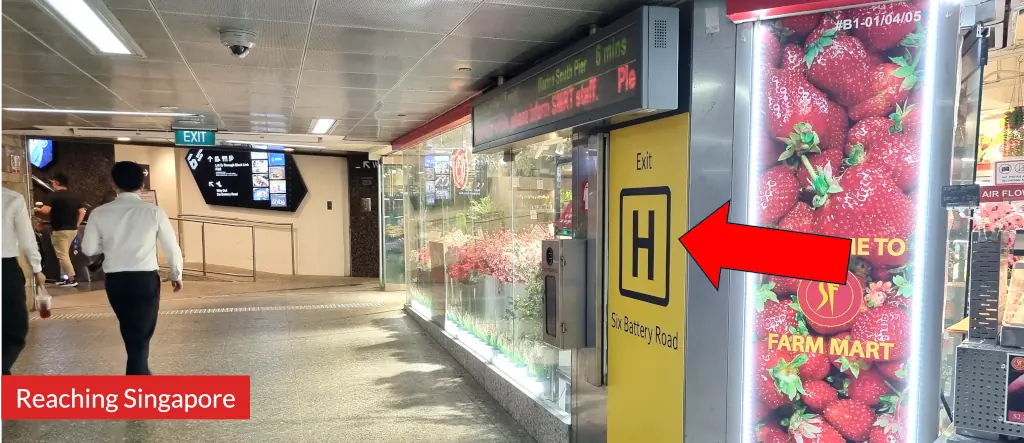
An interesting history of Singapore, including its transition from colonial administration to a modern republic, is documented along this underpass. Today the Fullerton Building is a hotel, but in the past it was used as the general post office and government administration office. This history is on display as you walk through the underpass and ride along the travelators.
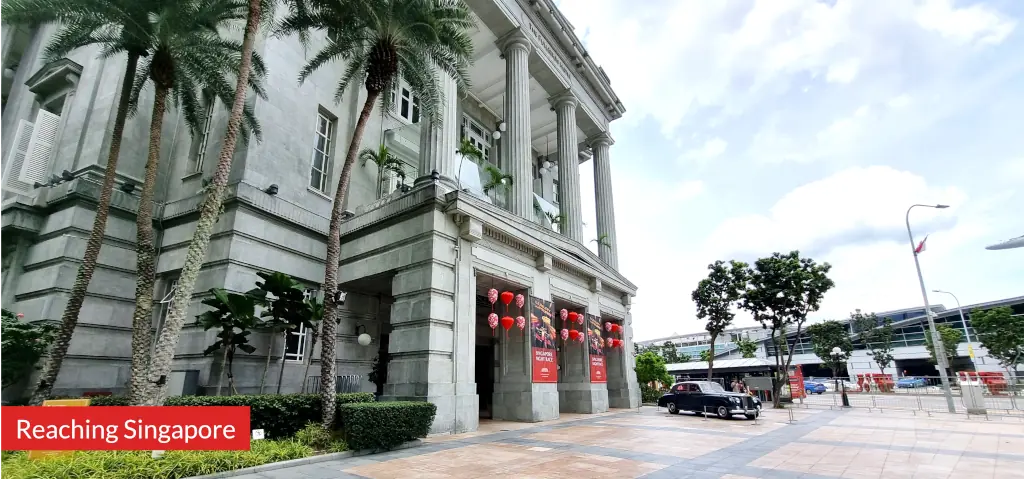
Within the underpass is the Philatelic Store @ Fullerton, which sells souvenirs of history associated with the post, as well as anything a Singapore philatelist would need. The Philatelic store is open from 9am to 6pm Monday to Friday.
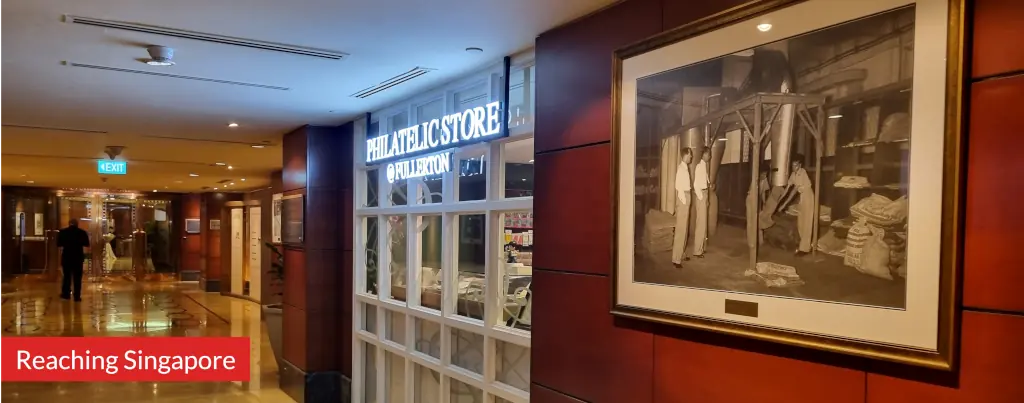
The Fullerton Building underpass is open 24 hours a day and can be accessed by escalators to the side of the entrance, or by walking through the hotel entrance and then proceeding down the stairs.
Costs of catching the MRT are roughly S$1.20 to S$1.80 per journey, depending on how far you travel. A single journey won’t cost more than S$2.37. Payment can be made by Visa or MasterCard (debit or credit card), prepaid EZ Link Card, or the Singapore Tourist Pass (I don’t usually recommend this, find out why here).
If you need help figuring out Singapore’s extensive train system, I wrote a full guide on how to navigate and how to pay for the MRT in Singapore. Check it out here: reachingsingapore.com/singapore-catch-train-guide
Merlion transport: Public bus
There are 8 regular bus routes serving the Merlion with the closest stops being Fullerton Square and OUE Bayfront / Collier Quay, depending on which direction you are travelling in. Routes of interest to visitors serving the Merlion include: 10, 57, 70, 100, 107, 130, 131, 167, and 196.
I usually only recommend using the bus to reach the Merlion if you are staying in Kampong Glam / Bugis (100, 107), or Little India (route 131). Everyone else should take the train.
Costs for buses are the same as trains - roughly S$1.20 to S$1.80 per journey depending on distance travelled. Payment is also by Visa or MasterCard (credit or debit), EZ Link, or Singapore Tourist Pass.
My full guide on how to catch the bus in Singapore is available here: reachingsingapore.com/singapore-catch-bus-guide.
Merlion transport: Big Bus Tours
Big Bus Tours are the iconic double-deck tour buses the ply the streets of major tourist cities around the world.
In Singapore, Big Bus Tours operate two routes: Yellow Line and Red Line.
The Merlion is served by the Yellow Line via the Fullerton Hotel stop. Cross the road at the traffic lights, walk through the building, and then turn left to get to the Merlion. You can also use the historic underpass inside the Fullerton Hotel to cross the road and get an interesting glimpse at the history of the Fullerton Building (underpass is publicly accessible).
Big Bus Tours are intended to be ‘hop-on hop-off’ meaning that you can get off the bus at any stop and then use your ticket to get on the next bus. This means you can ‘hop off’ at the Fullerton Hotel stop to get to the Merlion, then ‘hop-on’ again to go to the next stop.
The buses operate from 9:30am to 5:20pm daily and come roughly every 30 minutes (traffic depending).
Cost of a Big Bus Tour ticket is roughly S$60 per person for the first day, and they offer a significant discount if you’re buying multiple day tickets.
Merlion transport: Taxi
A taxi ride to the Merlion typically costs S$10 to S$20 depending on how far you are travelling, this budget should cover most hotels in the city. A higher fare will apply when coming from Changi Airport.
My preferred app for booking taxis is CDG Zig which is run by the taxi company Comfort. Other apps for taxis and ride hailing include Grab, Gojek, and TADA.
There are a lot of fees and surcharges associated with taking a taxi in Singapore and I’ve included more detail in my complete guide to taxis here: reachingsingapore.com/singapore-catch-taxi-guide.
Merlion transport: Cycle
I love cycling to the Merlion and I highly recommend it to anyone who is visiting. There are wide open paths to allow you to cycle from the Merlion, all the way around to Marina Bay Sands, and even further along to Gardens by the Bay. The views are some of the most iconic in Singapore.
Bicycle rental options I usually recommend to visitors in the area include:
- CityScoot @ Esplanade, S$25 for 3 hours
- GoCycling Marina Bay (the Singapore Flyer), S$10 per hour
- HelloRide and Anywheel bike share schemes, S$5-6 per hour
HelloRide and Anywheel require the app to be downloaded and used to unlock the bicycles for use.
When cycling around the Merlion note that the ramp to get up the stairs is off to the side and sign posted for disabled access. The first time I cycled here I dragged my bike up the few stairs there without realising there is a ramp.
Merlion transport: Boat
One of the companies operating Singapore river boat cruises has a jetty at the Merlion. WaterB operates boat tours to and from the Merlion. Other stops include Fort Canning and Bayfront North.
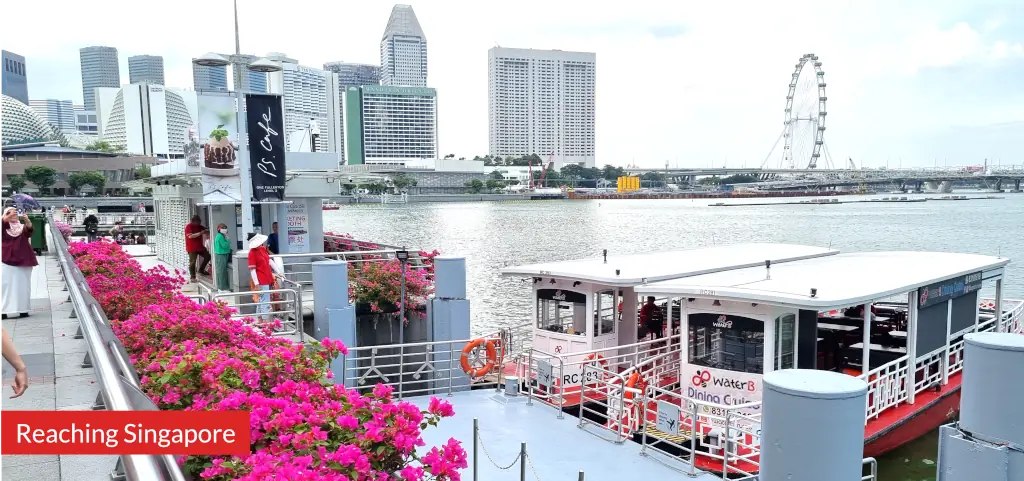
The tours operate between 2pm and 9pm daily with departures every half-hour or so. Each tour takes about 40 minutes.
Merlion transport: Private bus tour
The Merlion is a popular stop for group bus tours in Singapore. Coaches of tourists line the bridge leading up to the Merlion while their guests spend time soaking in the views over Marina Bay and taking selfies with the Merlion.
6. Best time to visit the Merlion
The Merlion is available 24 hours a day. He never shuts unless it’s due to maintenance (see below for best time of year to visit the Merlion).
My favourite time of day to visit the Merlion is at sunrise. The sun typically rises from the direction of the Flyer, giving you great light on the face of the Merlion when you are standing on the pier or the steps. It’s also cooler at this time of day.
I usually recommend visitors come at one of the following times:
| Time | Benefit |
|---|---|
| Before 11am | Cooler and not too crowded yet |
| After 5pm | Sunset also gives great lighting to the Merlion face, and it’s cooler |
| Evening around 8pm | See the light & water show in front of Marina Bay |
I recommend avoiding the 2pm to 5pm time as this is when the sun is hottest and there are many tour groups. It’s also the time of day it is most likely to rain in Singapore.
There is very little shelter at the Merlion as part of the enjoyment is the wide open space - there are only some trees for protection. I recommend bringing an umbrella to protect you from the sun or the rain.
The Merlion is also generally available 365 days a year. The best time to visit the Merlion is whenever you are visiting Singapore and its corresponding ‘season’ (hot or wet).
The Merlion usually has an annual maintenance period where it is closed for a few days. That is, for 2-3 days each year, the Merlion is unavailable. Closures are announced a few weeks in advance on the Singapore Tourism Board’s Media Releases page. I haven’t been able to predict the maintenance (and that’s even with my experience working in mechanical engineering maintenance in a past life), so I recommend checking the website for announcements before visiting. It’s uncommon though for the Merlion to be closed when you want to visit.
What next
Gardens by the Bay is very close to the Merlion, particularly if you’re cycling. I highly recommend it as there are many things you can do there for free. Check out my guide here.

